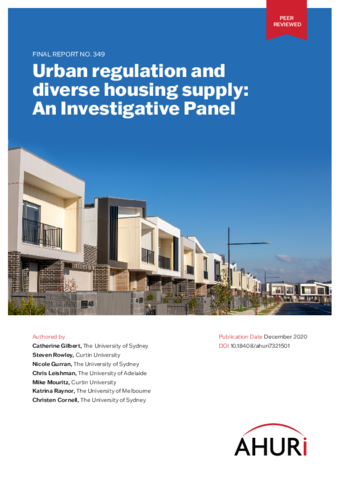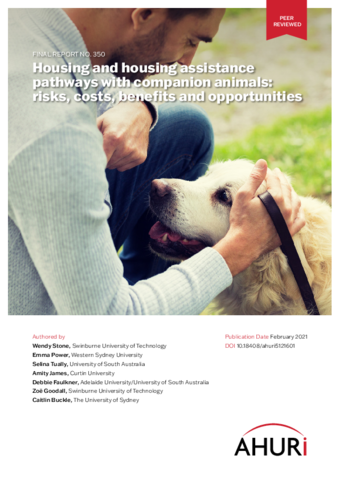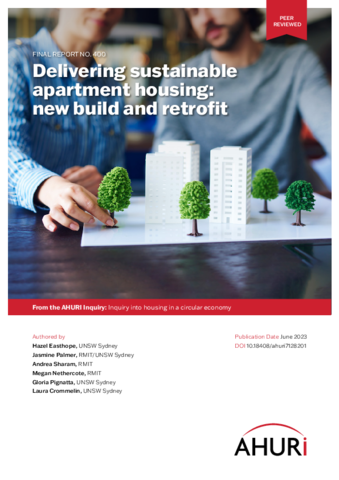
What is 'Build to rent'?
‘Build to rent’ is an established practice in the UK and USA but has yet to be fully taken up in Australia. This AHURI Brief explains the concept of ‘Build to rent’ and considers a number of issues relating to the sector.
02 Aug 2023
With unaffordable housing being a growing issue of concern for Australians, a potential solution to increasing the supply of rental housing is the ‘Build to rent’ development route.
‘Build to rent’ (BTR) is the process whereby developers and their financiers build multi-unit buildings and, instead of selling the units, retain them to rent to tenant households. Rents may be set at market rent or, for affordable and social housing, at an appropriate discount to market rents.
BTR is an established practice in both the UK (with over 149,000 BTR units completed or under development in 2020) and USA (where it is called Multi-Family Housing), and is starting to be taken up more fully in Australia. As announced in the 2023 Federal Budget, the Australian Government is encouraging investment in BTR, in particular through the reduction of withholding tax penalties for international investors who use managed investment trusts for investing in BTR. This puts BTR investments on the same taxation rate as other property investment options such as retail, hotels and corporate buildings.
The Australian BTR sector is small but is expected to grow
A 2022 report from Ernst and Young (EY) identified that the BTR sector in Australia is currently worth $16.87 billion, which comprises ‘roughly 0.2 per cent of the total value of the residential housing sector’, and equates to 23,000 apartments either completed (3,900 units) or in development (over 19,000 units).
BTR can provide more tenant-friendly’ housing
BTR housing may provide a number of benefits for tenants that may not be readily available for tenants of properties owned and rented out by small scale property investors.
A key factor is that BTR property managers see that they are offering long term rental services to customers rather than seeing themselves as property owners whose main income comes from capital gains acquired when they sell the property. As ‘professional landlords’, BTR managers can be expected to provide long, stable leases for their tenants, which means tenants can plan to live in a neighbourhood while, for example, children go to local schools, and they can build long term connections to the local community. There is also the opportunity to improve tenants’ quality of life when professional BTR managers allow them to keep a domestic animal as a pet or make aesthetic changes to apartments (such as changing wall colours).
In addition, BTR housing is likely to be maintained to a better standard as building owners know that they will own (and be responsible for) the buildings for very long periods of time. BTR property managers with a portfolio of buildings will also be able to negotiate better deals with maintenance companies for timely repairs.
BTR can be used to provide affordable housing as well as high-end housing
A criticism of early BTR projects in Australia was that they tended to cater to high-end tenants, offering a luxury product. However, affordable BTR projects are now emerging within Australia, primarily as components of larger scale developments that balance a proportion of affordable rental units (usually 10% of all units but possibly as high as 30% without government subsidy) with a greater proportion of higher market rental rate units.
Inclusionary zoning laws that require a proportion of all new housing developments within a defined geographical area to be affordable housing can also support delivering greater numbers of affordable BTR units.
The BTR model supports a higher priority on sustainable building and living
As BTR building owners can expect to own their buildings for long periods of time, they therefore have a long-term interest in the ongoing maintenance and operational costs of the building. This means they have strong financial incentives to ensure they design and construct better quality, more sustainable housing so as to attract and retain quality tenants. In turn, this can be expected to provide better comfort and more energy efficient housing for tenants.
BTR housing developments need regulation
While BTR has great potential benefits, it does need to be regulated. For example, ownership of too many units in an area by one owner (thereby creating a monopoly) means there is a risk to tenants and the community if the business owner puts up rents excessively or evicts everyone at the same time in order to refurbish/redevelop buildings.
In addition, if governments and communities give tax or planning benefits to BTR projects to support affordable or social housing, those benefits need to be preserved legally into the future through the use of planning covenants, such as charges on titles.



